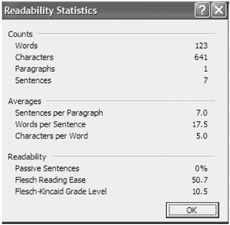Measuring Readability
|
Your car may be capable of going 150 miles an hour, but that doesn't mean it will benefit from continuous operation at that speed. Likewise, you may be capable of reading at the level of a college graduate, but that doesn't mean you'll want to all the time. Most people find it easier to read if the text is a couple of grade levels below the level of reading mastery they have achieved. In a proposal, you want to focus your reader's energy on understanding your ideas, not on the task of reading itself, so you should write at a comfortable, easy level.
Readability formulas measure how difficult or easy a given piece of writing is likely to be.
You can measure readability very easily by using tools built into your word processor. For example, if you use Microsoft Word, open the "Tools: Options: Spelling and Grammar'' box and select "Show Readability Statistics.'' The next time you use the "Tools: Spelling and Grammar'' option in Microsoft Word, you will see a chart that tells you more than you probably ever wanted to know about your writing. This chart, titled "Readability Statistics,'' tells you the percentage of passive sentences your writing contains. It also gives you the Flesch Reading Ease index and the Flesch-Kincaid Grade Level index. These numbers measure how easy or hard the writing is to decode. (WordPerfect users have a similar tool that also yields a Flesch-Kincaid Grade Level index.)
When I run a spelling and grammar check on the previous paragraph, I get this summary:

There's a lot of useful information here. I can see that my average sentence length is about right, and that I've completely avoided passive voice constructions. But what about the Flesch Reading Ease and Flesch-Kincaid Grade Level numbers? Are they good or bad?
The Reading Ease score is based on a standard of 100. The higher the number, the easier the writing is to understand. In business writing, which includes proposals, of course, a good score would be somewhere between 50 and 70. Based on that score, my paragraph is all right, but it could be simpler.
The Flesch-Kincaid Grade Level measurement indicates the equivalent U.S. grade level of reading competence that someone would need to read a particular passage easily. Note that this is strictly a measurement of the complexity of the writing. It does not mean the content is appropriate for someone at that level.
The chart below shows you how various grade levels correlate to mass-market publications. Note that grade level twelve is the danger line. Above that line, reading becomes uncomfortable for the majority of readers. Above fifteen, almost nobody is comfortable reading. Just because your reader has a Ph.D. doesn't mean you should write at a grade level of twenty. In fact, almost nobody enjoys reading for extended periods above an index of ten.
| INDEX | READING LEVEL BY GRADE | READING LEVEL BY MAGAZINE |
|---|---|---|
| 17 | College postgraduate | (No mass-market publication is this difficult.) |
| 16 | College senior | |
| 15 | College junior | |
| 14 | College sophomore | |
| 13 | College freshman | |
| 12 | High school senior | Scientific American The New Yorker, Atlantic Monthly |
| 11 | High school junior | |
| 10 | High school sophomore | Time, Newsweek Sports Illustrated daily newspapers People |
| 9 | High school freshman | |
| 8 | Eighth grade | |
| 7 | Seventh grade |
Other Ways to Improve Your Readability
Other factors besides sentence length and word choice will affect the ease with which your readers understand what you have written. Here are some you can control:
-
Legibility. Is your type easy to read? Don't use a font that's too small, because reading it will become a strain. Don't print type on a colored background that doesn't offer sufficient contrast.
-
Interest. If your reader is interested in what you're writing about, he or she will read comfortably at a slightly higher level than normal. That's another reason to lead with the content that is of greatest interest to your decision maker, rather than starting with your company history or an overview of your technology.
-
Format. Incorporating plenty of white space into your page design can make your text seem more readable. Headings, subheadings, the use of color, the use of sidebars, and illustrations can also help.
-
Simplicity. Presenting too many new ideas, new concepts, or new acronyms in a short space can discourage the reader. Most people have trouble, for example, keeping track of more than three or four new acronyms in a page of text before their mind goes blank and they lose the thread of your message.
|
EAN: 2147483647
Pages: 130